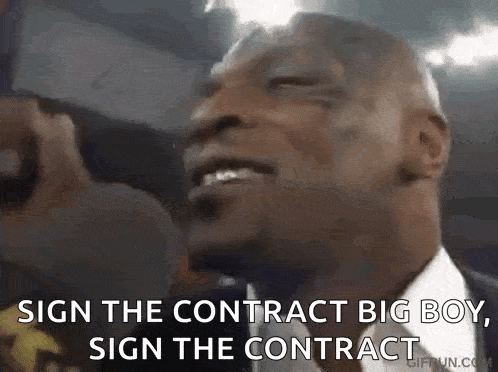
We all know that bad data in = bad data out.
When contract data is unstructured, everything downstream suffers.Manual billing and invoices, messy spreadsheets, and hours of reconciliation that never quite tie out.
Tabs fixes that.
We’re the AI-native revenue platform that automates the entire contract-to-cash cycle. Whether you're selling custom terms, usage-based pricing, or a mix of PLG and sales-led, Tabs turns month-end chaos into clean cash flow.
✅ Instantly generates invoices and revenue schedules from complex contracts✅ Automates dunning, revenue recognition, and cash application✅ Syncs clean, structured data across your ERP and reporting stack
Trusted by companies like Cortex, Statsig, and Cursor, Tabs powers the finance teams behind the next wave of category leaders.

Longer contracts can lock in revenue, lower CAC payback, and make your forecast look tight. But push too hard, or structure them the wrong way, and you’ll end up overselling, underdelivering, and facing a wall of churn 24 to 36 months out.
So…should you push your customers to sign longer? And if so, how do you make it a win-win?
1. What’s in it for YOU as a SELLER
Revenue Certainty: Multi-year deals improve ARR visibility and investor optics. This is especially valuable in PE-backed contexts where predictability boosts valuation multiples.
If you want to go deep on Remaining Performance Obligation (RPO) check it out here
There’s a sleeper metric CFOs in tech are increasingly relying upon to tell their equity story - it's called Remaining Performance Obligation, or RPO for short. It's cool because it gives companies a way to show off the multi-year contracts they've landed with customers, and provide additional confidence on the company’s ability to deliver on revenue expectations.
It's particularly relevant for businesses that do a lot of long-term stuff in the form of multi year subscriptions. Instead of just looking at what's in the bank right now, RPO gives you the full picture of what's in the pipeline.
It's like seeing the whole iceberg, not just the tip.

Operational Leverage: Less time chasing renewals means more time focused on expansion, cross-sell, or new logos.
Cash Flow: Annual prepayment or multi-year upfronts can fund future product development, if your working capital needs and burn support it.
If a customer pays you upfront each year, they’re funding future development (which will help retain them) and allowing you to collect interest on their cash.
2. What’s in it for THEM as a BUYER
Cost Predictability: Helps them model spend next year.
CFOs love to know what they’re going to pay ahead of time.
Inflation Hedge: Shields from year-over-year price increases.
Side note: It feels like every time I’ve done a one year deal with Salesforce they’ve tried to raise the price by minimally 8% y/y for the same stuff.

Psychological Win: A discount gives budget holders a reason to feel like they negotiated something tangible.
Sometimes you need to let the customer feel like they “won”
Procurement Considerations: Keep in mind that not all customer segments are created equal.
For enterprise accounts with procurement rigor and budget predictability, long-term deals often make sense. You’d rather avoid the mine filled, booby trap of large company procurement for another year if possible.
For SMB or mid-market, trying to force a three-year contract can be more hassle than it’s worth. They just don’t like to do business that way.
Plus, if they are small today, does that mean they will be small tomorrow? If you think they are poised to take off, actually NOT locking them into a longer term contract can set you up for a larger renewal in a year.
So match your contract strategy to the customer’s sophistication, and their ability to forecast growth. Speaking of that…
3. Are You Ready for the Renewal… Today?
If you’re 98.5% confident they’ll renew, a shorter contract might actually be a compelling event to upsell or re-price.
A multi year contract can cannibalize an opportunity to speak to your customer and get them to buy even more
Having a touchpoint on the calendar is an asset in and of itself
And that’s the beauty of SaaS in many ways - every year you get a built in negotiation period, if you choose to structure it that way
Plus, locking in low value or over-discounted deals just to hit a number today can boomerang badly tomorrow.
Yes, you have revenue predictability, but you’ve also capped your upside and growth rate. You checked the box on retention, but are losing the larger game of growth.
Ask: If I had to re-earn this customer next quarter, what would I change?
Thanks for reading Looking for Leverage! This post is public so feel free to share it.
4. Structuring the Deal Right
Guardrails for Sales: Incentivize reps to prioritize customer value, not just deal size.
Avoid the zero-interest-rate-era trap of selling “usage we hope they’ll grow into.”
This actually reduces total lifetime value in the longer term, as customers become resentful that they were oversold and will churn out the top when the next best alternative arises.
Payment Terms: Get clarity on what “multi-year” really means in terms of cash. Are they prepaying annually? Quarterly? Fully upfront? Each model has drastically different implications for your cash flow model.
A wild trend: Companies paying for multiple years up front so they can call thier OPEX spend CAPEX
More than ARR: When sales teams are comped purely on closed ARR, the temptation to oversell skyrockets.
Without guardrails, you’ll manufacture churn 24 months out while showing inflated performance today.
Structure comp plans to reward not just bookings, but adoption and renewal.
5. The Capital Markets Lens
In a high interest rate environment, upfront payments are more valuable, both to your cash position and your internal IRR.
If you’re collecting a large sum of cash now, you can invest it in product, go-to-market, or working capital, effectively arbitraging the cost of capital.
Think like a portfolio manager: Would you rather have $2M now and $0 later, or $1M annually for the next three years?
Time value of money matters, but so does retention and expansion potential.
Quick PSA: You’re not a bank. And you don’t pretend to play one on television.
Don’t trade long-term margin for a short-term cash spike.
Evaluate whether the upfront cash creates a compounding advantage, or just plugs a hole this quarter.
TL:DR: Long-term contracts only create leverage if you’ve earned them.
As I discussed with Tony Kim, Managing Director at Blackrock, contract length on it’s own is not a measure of revenue durability.
Yes, subscription is great - it’s recurring - meaning you can reliably expect payment in a predetermined amount at a series of predetermined times.
But subscription contracts, in and of itself, are a payment construct; they are not the essence of durability. We can’t conflate the two.
“I have some two year contract app with a note taking application or a collaboration work management tool, I’ve gone through four of them in the last six years. It’s subscription! It’s SaaS! It’s durable right?
No, that’s not durability. I’ve been doing this for 25 years. I’ve had Bloomberg for 25 years. That’s durability. That’s not a metric or KPI. That’s a qualitative assertion of what has this duration. Durability withstood the hand of time.”
Durability revolves around a technology's sustained usage and necessity over an extended period, often despite changes or advancements in the field. It isn't just about subscription models or being a software as a service; it's about technologies becoming so essential and ingrained in operations that they are less likely to be replaced than other parts of an organization.
Knowing if your product is essential is part of the decision making process to sign customers up to multi year deals. Use contracts to build mutual value, not just lock customers in. And structure incentives, internally and externally, so everyone wins on renewal, not just signature.
